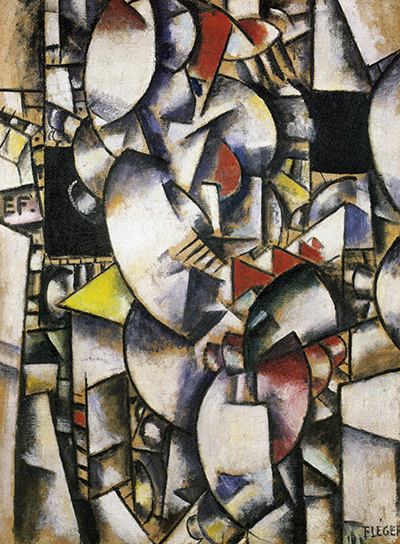Naked Model in the Workshop continues Fernand Leger's own unique take on Cubism, sometimes referred to as Tubism. It was the dark outlines, gradients of colour and particular arrangements of geometric shapes that makes his work so instantly recognisable.
Leger completed Naked Model in the Workshop in 1913, just before WW1. During his time away at war the artist continued to use this form of cubism in his paintings, though was forced to limit his content to elements related to his environment. In most cases, this would be his colleagues in various poses and he also spent considerable time practicing his drawing skills, with sketchbooks more easily available. It would always be easier for Leger to work from his studio but the war did bring in new influences and ideas, and the horrors of it also suited some of his darker colour schemes that are found in much of his work during this time. This was an artist who reduced his scenes down to a series of geometric shapes, sometimes with long sweeping curves where limbs of a model were added. In this painting he makes use of a number of small triangles which jut out at seemingly random angles.
The colour scheme is typically simple, predominantly grayscale, with some primary and secondary colours then filling some of the more important shapes. There are also highly detailed, smaller items added into the background where space lies between the larger shapes of the foreground.Naked Model in the Workshop is perhaps one of the harder paintings in which to distinguish the elements of the scene. The artist signed this piece in the bottom right hand corner, just as he did with most of his artworks. He also signed many of his drawings, typically the ones with greater detail rather than any more experimental sketches. Leger is perhaps not famous for any particular painting, but more so his consistent style of Cubism which can be found in most of his paintings.
This painting is loosely dated at 1912-1913 by its present owners but most sources see it as more likely being from the later year. It sits within the collection of the Guggenheim, an important art institution which now boasts several different venues which rotate its huge collection between their considerable display space. They specialise mostly in contemporary art and host a number of different artworks from Fernand Leger, in the mediums of both painting and drawing. His connection to both Paul Cezanne as well as the other members of the Cubist movement has made his career highly significant and regularly features within most studies of contemporary art from the first half of the 20th century. The galleries under their control will also sometimes loan out parts of their collection in order to ensure that as much of it can be viewed by the public as possible.
This artwork features very clear lines, with sharp curves and straighter triangles which jut out seemingly at random. There is not a huge use of colour within this painting, with mostly subdued tones placed into each and every shape, other than the occasional use of red, blue and yellow. In doing this, the artist was intending to encourage the viewer to focus upon the shapes that he had added within the composition, rather than being distracted by a brighter palette. There is also a strong use of shading, which helps to create a feeling of depth, which also makes it easier to differentiate one object from another. Leger was keen to create his own unique world within his paintings from this period and perspective could still be used, even with a new form of content.




